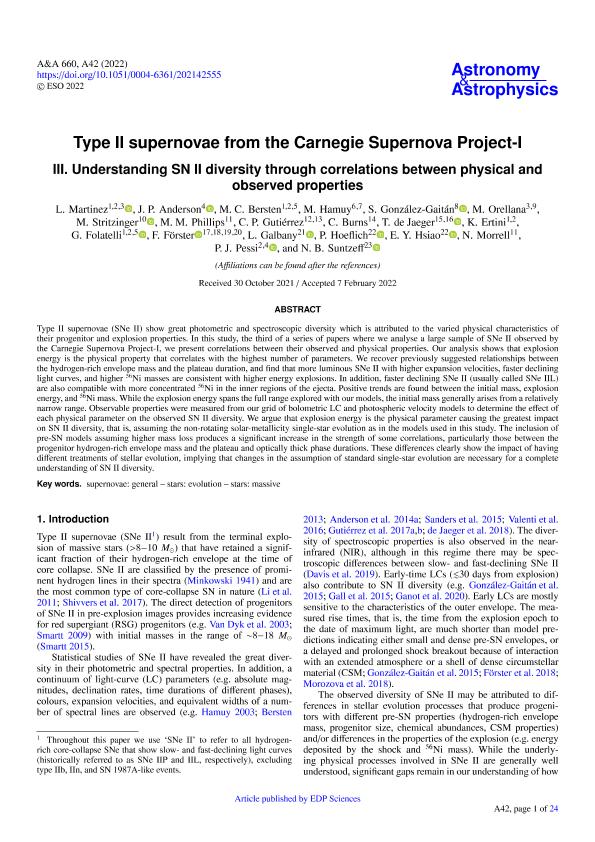Mostrar el registro sencillo del ítem
dc.contributor.author
Martinez, Laureano

dc.contributor.author
Anderson, J. P.
dc.contributor.author
Bersten, Melina Cecilia

dc.contributor.author
Hamuy, Mario

dc.contributor.author
González-Gaitán, S.
dc.contributor.author
Orellana, M.
dc.contributor.author
Stritzinger, M. D.
dc.contributor.author
Phillips, M. M.
dc.contributor.author
Gutiérrez, C. P.
dc.contributor.author
Burns, C.
dc.contributor.author
de Jaeger, T.
dc.contributor.author
Ertini, Keila Yael

dc.contributor.author
Folatelli, Gaston

dc.contributor.author
Förster, F.
dc.contributor.author
Galbany, Lluís

dc.contributor.author
Hoeflich, Peter

dc.contributor.author
Hsiao, Eric

dc.contributor.author
Morrell, Nidia Irene

dc.contributor.author
Pessi, Priscila Jael

dc.contributor.author
Suntzeff, Nicholas B.

dc.date.available
2023-09-19T00:22:55Z
dc.date.issued
2022-04
dc.identifier.citation
Martinez, Laureano; Anderson, J. P.; Bersten, Melina Cecilia; Hamuy, Mario; González-Gaitán, S.; et al.; Type II supernovae from the Carnegie Supernova Project-I: III. Understanding SN II diversity through correlations between physical and observed properties; EDP Sciences; Astronomy and Astrophysics; 660; A42; 4-2022; 1-24
dc.identifier.issn
0004-6361
dc.identifier.uri
http://hdl.handle.net/11336/211911
dc.description.abstract
Type II supernovae (SNe II) show great photometric and spectroscopic diversity which is attributed to the varied physical characteristics of their progenitor and explosion properties. In this study, the third of a series of papers where we analyse a large sample of SNe II observed by the Carnegie Supernova Project-I, we present correlations between their observed and physical properties. Our analysis shows that explosion energy is the physical property that correlates with the highest number of parameters. We recover previously suggested relationships between the hydrogen-rich envelope mass and the plateau duration, and find that more luminous SNe II with higher expansion velocities, faster declining light curves, and higher 56Ni masses are consistent with higher energy explosions. In addition, faster declining SNe II (usually called SNe IIL) are also compatible with more concentrated 56Ni in the inner regions of the ejecta. Positive trends are found between the initial mass, explosion energy, and 56Ni mass. While the explosion energy spans the full range explored with our models, the initial mass generally arises from a relatively narrow range. Observable properties were measured from our grid of bolometric LC and photospheric velocity models to determine the effect of each physical parameter on the observed SN II diversity. We argue that explosion energy is the physical parameter causing the greatest impact on SN II diversity, that is, assuming the non-rotating solar-metallicity single-star evolution as in the models used in this study. The inclusion of pre-SN models assuming higher mass loss produces a significant increase in the strength of some correlations, particularly those between the progenitor hydrogen-rich envelope mass and the plateau and optically thick phase durations. These differences clearly show the impact of having different treatments of stellar evolution, implying that changes in the assumption of standard single-star evolution are necessary for a complete understanding of SN II diversity.
dc.format
application/pdf
dc.language.iso
eng
dc.publisher
EDP Sciences

dc.rights
info:eu-repo/semantics/openAccess
dc.rights.uri
https://creativecommons.org/licenses/by-nc-sa/2.5/ar/
dc.subject
STARS: EVOLUTION
dc.subject
STARS: MASSIVE
dc.subject
SUPERNOVAE: GENERAL
dc.subject.classification
Astronomía

dc.subject.classification
Ciencias Físicas

dc.subject.classification
CIENCIAS NATURALES Y EXACTAS

dc.title
Type II supernovae from the Carnegie Supernova Project-I: III. Understanding SN II diversity through correlations between physical and observed properties
dc.type
info:eu-repo/semantics/article
dc.type
info:ar-repo/semantics/artículo
dc.type
info:eu-repo/semantics/publishedVersion
dc.date.updated
2023-09-14T17:41:43Z
dc.journal.volume
660
dc.journal.number
A42
dc.journal.pagination
1-24
dc.journal.pais
Francia

dc.journal.ciudad
Paris
dc.description.fil
Fil: Martinez, Laureano. Consejo Nacional de Investigaciones Científicas y Técnicas. Centro Científico Tecnológico Conicet - La Plata. Instituto de Astrofísica La Plata. Universidad Nacional de La Plata. Facultad de Ciencias Astronómicas y Geofísicas. Instituto de Astrofísica La Plata; Argentina
dc.description.fil
Fil: Anderson, J. P.. European Southern Observatory Chile.; Chile
dc.description.fil
Fil: Bersten, Melina Cecilia. Consejo Nacional de Investigaciones Científicas y Técnicas. Centro Científico Tecnológico Conicet - La Plata. Instituto de Astrofísica La Plata. Universidad Nacional de La Plata. Facultad de Ciencias Astronómicas y Geofísicas. Instituto de Astrofísica La Plata; Argentina
dc.description.fil
Fil: Hamuy, Mario. Texas A&M University; Estados Unidos
dc.description.fil
Fil: González-Gaitán, S.. Universidade de Lisboa; Portugal
dc.description.fil
Fil: Orellana, M.. Consejo Nacional de Investigaciones Científicas y Técnicas; Argentina
dc.description.fil
Fil: Stritzinger, M. D.. University Aarhus; Dinamarca
dc.description.fil
Fil: Phillips, M. M.. Carnegie Observatories; Estados Unidos
dc.description.fil
Fil: Gutiérrez, C. P.. University Of Turku; Finlandia
dc.description.fil
Fil: Burns, C.. Observatories Of The Carnegie Institution For Science; Estados Unidos
dc.description.fil
Fil: de Jaeger, T.. University Of Hawaii; Estados Unidos
dc.description.fil
Fil: Ertini, Keila Yael. Consejo Nacional de Investigaciones Científicas y Técnicas. Centro Científico Tecnológico Conicet - La Plata. Instituto de Astrofísica La Plata. Universidad Nacional de La Plata. Facultad de Ciencias Astronómicas y Geofísicas. Instituto de Astrofísica La Plata; Argentina
dc.description.fil
Fil: Folatelli, Gaston. Consejo Nacional de Investigaciones Científicas y Técnicas. Centro Científico Tecnológico Conicet - La Plata. Instituto de Astrofísica La Plata. Universidad Nacional de La Plata. Facultad de Ciencias Astronómicas y Geofísicas. Instituto de Astrofísica La Plata; Argentina
dc.description.fil
Fil: Förster, F.. Universidad de Chile.; Chile
dc.description.fil
Fil: Galbany, Lluís. Institute Of Space Sciences; España
dc.description.fil
Fil: Hoeflich, Peter. Florida State University; Estados Unidos
dc.description.fil
Fil: Hsiao, Eric. Florida State University; Estados Unidos
dc.description.fil
Fil: Morrell, Nidia Irene. Carnegie Observatories; Estados Unidos. Consejo Nacional de Investigaciones Científicas y Técnicas. Centro Científico Tecnológico Conicet - La Plata. Instituto de Astrofísica La Plata. Universidad Nacional de La Plata. Facultad de Ciencias Astronómicas y Geofísicas. Instituto de Astrofísica La Plata; Argentina
dc.description.fil
Fil: Pessi, Priscila Jael. Consejo Nacional de Investigaciones Científicas y Técnicas. Centro Científico Tecnológico Conicet - La Plata. Instituto de Astrofísica La Plata. Universidad Nacional de La Plata. Facultad de Ciencias Astronómicas y Geofísicas. Instituto de Astrofísica La Plata; Argentina. European Southern Observatory Chile.; Chile
dc.description.fil
Fil: Suntzeff, Nicholas B.. Texas A&M University; Estados Unidos
dc.journal.title
Astronomy and Astrophysics

dc.relation.alternativeid
info:eu-repo/semantics/altIdentifier/doi/http://dx.doi.org/10.1051/0004-6361/202142555
dc.relation.alternativeid
info:eu-repo/semantics/altIdentifier/url/https://www.aanda.org/articles/aa/full_html/2022/04/aa42555-21/aa42555-21.html
Archivos asociados
